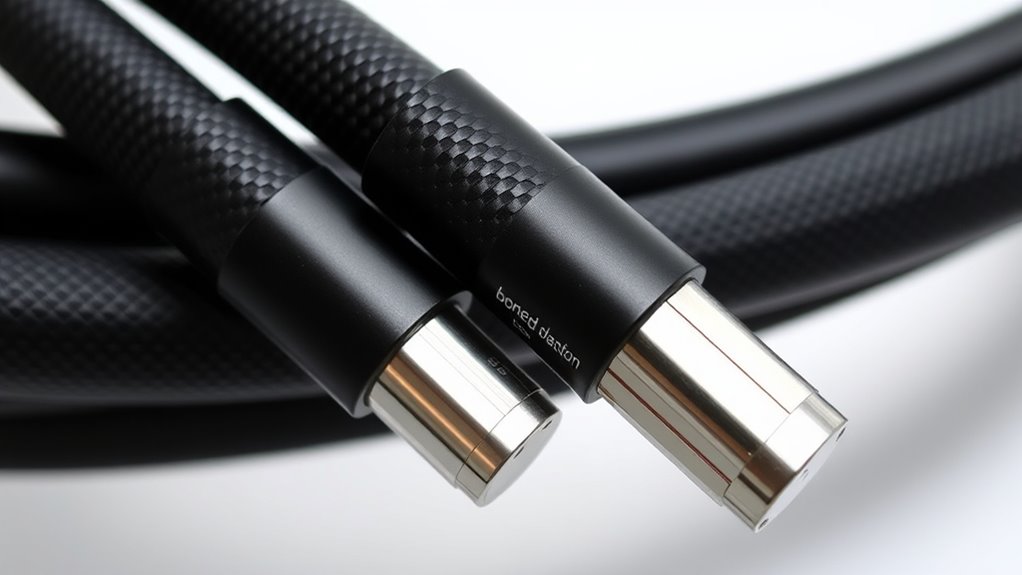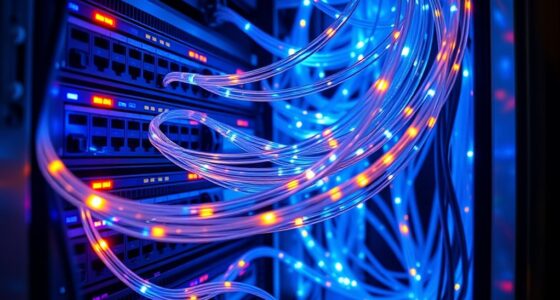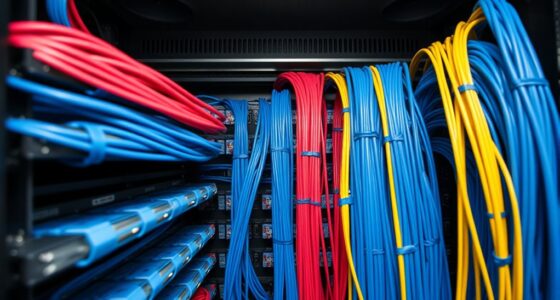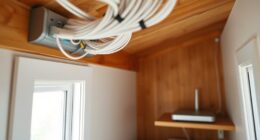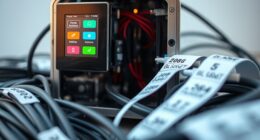Bonded-pair cables feature twisted pairs of insulated wires bonded together with shielding to protect signals from external interference. This design helps reduce noise, crosstalk, and electromagnetic interference, ensuring clearer and more reliable data transmission. The twisting minimizes interference from nearby sources, while bonding and shielding provide extra protection in noisy environments. If you want to understand how these cables boost signal integrity and why they matter in critical systems, there’s more to learn ahead.
Key Takeaways
- Bonded-pair cables feature twisted insulated conductors bonded together for enhanced stability and microphonics reduction.
- Twisting pairs minimizes electromagnetic interference (EMI) and crosstalk, improving signal clarity over long distances.
- They often include shielding, such as foil or braid, to protect against external noise and electromagnetic fields.
- The bonded design ensures structural stability, easier installation, and consistent performance in noisy environments.
- These cables are ideal for networking, industrial, and telecommunications applications requiring reliable, high-quality signals.

Bonded-pair cables are a type of twisted pair cable designed to improve signal integrity and reduce electromagnetic interference. When you’re dealing with data transmission, especially over longer distances or in environments filled with electrical noise, maintaining a clear, consistent signal is essential. That’s where bonded-pair cables shine. They use multiple insulated conductors twisted together, which helps cancel out interference from external sources. This twisting isn’t just for organization; it’s a deliberate strategy to guarantee the signals stay clean. The twisting of each pair minimizes the loop area, reducing susceptibility to electromagnetic interference (EMI) and crosstalk from neighboring cables or equipment.
Bonded-pair cables use twisted insulated conductors to minimize interference and ensure signal clarity.
Cable shielding plays a critical role in boosting the performance of bonded-pair cables. Shielding involves adding a conductive layer around the twisted pairs, which acts as a barrier against external noise. There are various types of shielding, such as foil, braid, or a combination of both, each offering different levels of protection. When you select a bonded-pair cable with proper shielding, you greatly decrease the chances of signals being distorted or lost due to external electromagnetic fields. Shielding is especially important in industrial settings or areas with high electrical activity, where interference can be intense. It helps guarantee that your data remains intact, reducing errors and boosting overall transmission reliability.
In addition to shielding, the design of bonded-pair cables often incorporates a solid insulation material around each conductor, further reducing crosstalk between pairs. This is essential because even minor interference can cause data corruption or slower speeds. The bonded aspect of these cables refers to the way the pairs are physically bonded together, providing structural stability and easier installation. It also helps maintain the cable’s shape and reduces microphonics, which are unwanted signals caused by cable movement or vibration. Electrical noise suppression is a key benefit of bonded-pair cables, especially in complex environments.
When you’re choosing bonded-pair cables, consider the environment and the level of interference you expect. Cables with enhanced cable shielding and robust twisting will give you better performance in noisy environments. They’re ideal for networking, telecommunications, and industrial automation where data integrity is non-negotiable. By understanding how the combination of twisted pairs and effective cable shielding works together, you can select a cable that guarantees your signals stay strong, clear, and reliable throughout your entire system.
Frequently Asked Questions
How Do Bonded-Pair Cables Improve Signal Integrity?
Bonded-pair cables improve signal integrity by reducing electromagnetic interference and signal attenuation. When the pairs are bonded, they stay tightly together, which minimizes crosstalk and external noise. This stability helps your signals stay clear and strong over longer distances. By preventing interference and maintaining consistent signal strength, bonded-pair cables guarantee you get reliable data transmission without loss or distortion.
Are Bonded-Pair Cables Suitable for Outdoor Installations?
Yes, bonded-pair cables are suitable for outdoor installations if you follow proper grounding techniques and installation best practices. For example, in a recent case, a telecommunications company successfully deployed bonded-pair cables outdoors by ensuring they were properly shielded and grounded to prevent moisture and interference. Always use weather-resistant conduits and connectors, and maintain good drainage. This guarantees reliable performance and long-term durability in outdoor environments.
What Are the Common Materials Used in Bonded-Pair Cables?
You’ll find bonded-pair cables use various material types, primarily copper or aluminum, for conductor composition due to their excellent electrical conductivity. The insulation often consists of polyethylene, PVC, or other durable plastics to protect against environmental factors. These materials guarantee reliable performance, flexibility, and durability, especially in demanding installations. Knowing the material types helps you select the right bonded-pair cable for your specific application, whether indoor or outdoor.
How Does Bonding Affect Cable Durability and Lifespan?
Bonding dramatically boosts your cable’s durability and lifespan, making it virtually unstoppable! By incorporating proper grounding techniques and following installation standards, you protect against electrical surges and environmental damage. This reduces wear and tear, ensuring your cables stay intact longer, even in harsh conditions. Proper bonding creates a shield of resilience around your cables, so they endure daily stress, temperature changes, and interference—keeping your system reliable for years to come.
Can Bonded-Pair Cables Be Repaired Easily if Damaged?
Repairing bonded-pair cables can be challenging due to their design, which makes accessing individual pairs difficult. You might face repair challenges because damaging one part often affects the whole cable, increasing the complexity. Cost considerations also come into play, as repairs could be expensive if specialized tools or expertise are needed. Overall, it’s usually more practical to replace damaged bonded-pair cables rather than attempt complex repairs yourself.
Conclusion
Now that you understand bonded-pair cables, you see how they serve as steadfast, secure strands in your network’s structure. Their durability and dependable design deliver data seamlessly, shielding your system from surges and snares. By choosing bonded pairs, you boost both boldness and balance in your connection. So, prioritize these powerful, protective pairs to keep your cables consistent, clean, and connected—because in the world of wiring, wise choices weave a winning web.
